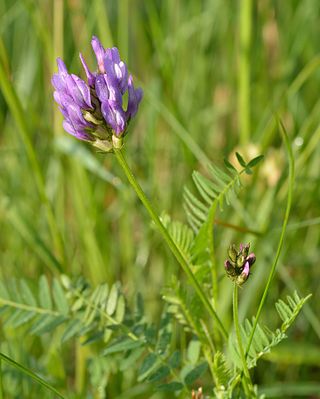
Astragalus is a large genus of over 3,000 species of herbs and small shrubs, belonging to the legume family Fabaceae and the subfamily Faboideae. It is the largest genus of plants in terms of described species. The genus is native to temperate regions of the Northern Hemisphere. Common names include milkvetch, locoweed and goat's-thorn. Some pale-flowered vetches are similar in appearance, but they are more vine-like than Astragalus.
Astragalus bidentatus is a species of plant in the family Fabaceae. It is found only in Ecuador in two locations in the south above the timberline in the Azuay and Cañar provinces. Its natural habitat is subtropical or tropical high-altitude grassland. No specimens have been taken since 1945 and none are contained in museums. It is most commonly found in the month of July.
Astragalus cavanillesii is a species of legume in the family Fabaceae. It is found only in Spain. Its natural habitat is Mediterranean-type shrubby vegetation. It is threatened by habitat loss.

Astragalus geminiflorus is a species of legume in the family Fabaceae. It is found only in Ecuador. Its natural habitat is subtropical or tropical high-altitude grassland.

Astragalus nitidiflorus is a species of legume in the family Fabaceae. It is endemic to Cartagena, southeast of Spain. It was refound after about 100 years of extinction and "the reappearance of this species has awakened the interest of environmental managers because the reasons for its critical situation are unknown". In 2004, a group of 46 specimens were discovered in a protected area between Cartagena and Mazarrón and plans for the conservation of this species have been implemented. ISSR markers helped to find that Astragalus nitidiflorus has a low genetic diversity. "This species grows in shallow soil from metamorphic and volcanic rocks in between mountain and cultivated areas".
Astragalus sprucei is a species of legume in the family Fabaceae. It is found only in Ecuador. Its natural habitat is subtropical or tropical moist montane forests.

The Turkestan ground jay, grey ground jay or Pander's ground-jay is a species of bird in the crow and jay family, Corvidae. It is found in central Asia, particularly Kazakhstan, Turkmenistan, and Uzbekistan. More specifically, they tend to be found in Astragalus, Calligonum and southern Salsola vegetation zones. It is closely related to the Iranian ground jay. Its natural habitat is sandy desert with low shrub cover. It also forages around human settlements and roads.
Astragalus crotalariae is a species of milkvetch known by the common name Salton milkvetch. It is native to the Colorado Desert in California and other Sonoran Deserts in Arizona and northern Mexico. It grows in desert scrub habitat, including the Salton Sink in the Coachella Valley.

Astragalus didymocarpus is a species of milkvetch known by the common names Dwarf white milkvetch and Two-seeded milkvetch. It is native to the southwestern United States and northern Mexico, where it can be found in many types of habitat.
Astragalus leucolobus is a species of milkvetch known by the common names Bear Valley milkvetch and Bear Valley woollypod.
Astragalus oltensis, the Oltuan astracantha, is a species of milkvetch that is endemic to Kars Province in Turkey. It is known only from its type specimen, and has not been collected again since. It was found on stony slopes at about 1,100 m elevation. It is threatened by overgrazing and erosion.
Astragalus acmophylloides, the sharp-leaved milkvetch, is a species of milkvetch that is endemic to Erzurum and Artvin provinces. in Turkey. It can be found at pine forest edges at about 1,700 m elevation. It is threatened by dam construction and overgrazing.
Astragalus geminus, synonym Astragalus albanicus, is a species of milkvetch that is native to the east Caucasus. Under the synonym Astragalus albanicus, the 2014 IUCN Red List assessed it as "endangered", stating that it was endemic to the Abşeron and Gobustan districts of Azerbaijan, where it can be found on dry clayey sites and shingle slopes up to the mid montane zone and is threatened by small-scale development.
Astragalus aspindzicus, the Aspindzian astragalus, is a species of milkvetch that is endemic to the Meskheti region in southern Georgia.
Astragalus pendulus, synonym Astragalus coelestis, is a species of milkvetch native to Iran, the Transcaucasus and Turkey.

Astragalus danicus, known as purple milk-vetch, is a species of flowering plant in the family Fabaceae (legumes), which is native to Europe.

Astragalus crassicarpus, known as ground plum or buffalo plum, is a perennial species of flowering plant in the legume family, Fabaceae, native to North America. It was described in 1813. The fruit is edible and was used by Native Americans as food and horse medicine. It is a host of afranius duskywing larvae. It is also known as groundplum milkvetch and pomme de prairie.

Astragalus microcephalus is a species of flowering plant in the family Fabaceae, native from Bulgaria to Iran. It was first described by Carl Ludwig Willdenow in 1802. The species and its two subspecies have acquired a large number of synonyms. Under a synonym of Astragalus microcephalus subsp. microcephalus, Astragalus atenicus, plants occurring in Georgia were assessed as "vulnerable".
Astragalus ornithopodioides is a species of flowering plant in the family Fabaceae, native to west and north Iran, the South Caucasus (Transcaucasus) and Turkey. It was first described by Jean-Baptiste Lamarck in 1783. Under the synonym Astragalus bylowae, a population occurring in Armenia was assessed as "vulnerable" in 2006.








